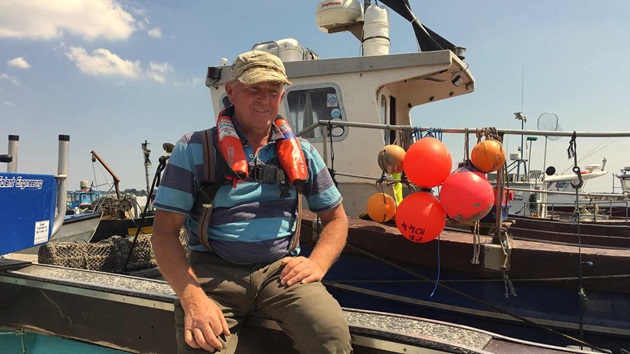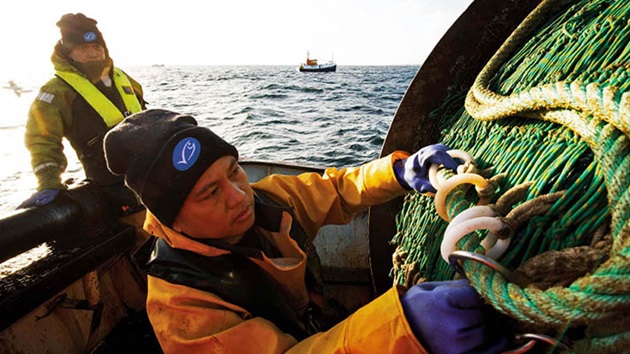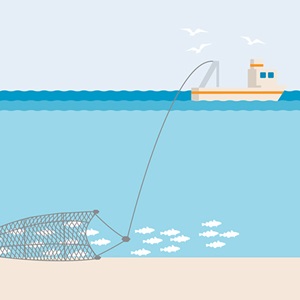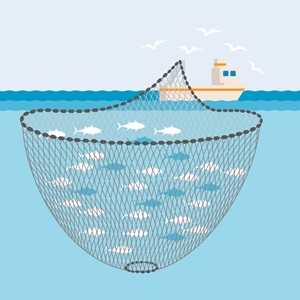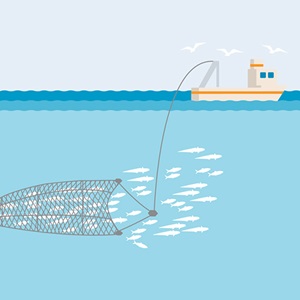Can seafood caught using dredges be sustainable? Find out more about this gear type and how its impact on the environment can be reduced.
What are dredges?
Dredges are rigid structures that are towed along the seabed and used to harvest species living in or on the seabed, such as scallops, oysters and clams.
The design of a dredge varies depending on the species being targeted, but it typically consists of a metal frame with a bar at the front, and a collecting bag at the back. The bar - which can have a row of metal teeth - is pulled along the surface of the seabed or raked through the sediment.
Dredges are used worldwide in offshore and inshore fisheries, and may be operated by hand in shallow waters, or towed by a fishing boat. Multiple dredge frames can be attached to a single vessel – with large vessels capable of towing up to 20 frames.
/dredging-gear-illustration.tmb-large1920.jpg?Status=Master&Culture=en&sfvrsn=d5c5641_1)
Is dredge fishing harmful?
Dredges are designed to disturb the seabed, and so fisheries must be well-managed to minimise the environmental impacts that this gear can cause.
Dredging can damage key habitats, such as seagrass meadows, corals and maerl beds which provide shelter and nursery grounds for a wide range of species. Organisms that live on - or burrow into - the seabed may be accidentally caught (bycatch), damaged by the dredge, or exposed to predators. Ultimately, these impacts can change the composition of seabed communities, making them less complex and less diverse.
Reducing environmental impacts
To reduce the environmental risks, there are often strict regulations on the types of dredges permitted, where they operate, and the frequency of use. Fisheries can also take a range of steps to reduce the impact of using dredge gears.
Habitat mapping
Understanding the area a fishery operates in and mapping the location of sensitive habitats is key to reducing the impact of dredging.
Impacts vary according to factors such as the composition of the seabed, and exposure to environmental conditions. For example, sandy, muddy or gravel sediments are more likely to recover from dredging, particularly in regions frequently exposed to strong tides and currents.
The MSC certified Poole Harbour clam and cockle fishery operates in an area containing several protected sites, demonstrating how effective fisheries management can enable the coexistence of dredging alongside key habitats.
Fishing activity has been tracked and mapped against such habitats, with dredging bans implemented by the local authorities to protect saltmarshes where migratory birds nest and seagrass meadows which support seahorse populations. An annual assessment is also carried out to establish the fishery’s risk to each key site and the wider harbour ecosystem.
Implementing closures
The impact of dredging can also be reduced through spatial or temporal closures. Not only does this allow the seabed to recover in those areas, but it supports healthy stocks by allowing the target species to replenish.
The MSC certified US Atlantic scallop fishery is carefully managed using a rotation system, where areas of the fishing grounds are closed for two to three years. This helps make fishing operations more efficient as areas containing juvenile or undersized scallops are protected until the scallops reach an optimum size. Restricting fishing activities to defined areas also reduces the footprint, and therefore impact, of the fishery.
Area closures can also be an effective way to reduce bycatch of non-target species. The MSC certified Eastern Canada offshore scallop fishery closes for several months each year to avoid disrupting the spawning seasons for cod and to protect yellowtail flounder.
Modifying gear
Significant research has been carried out to identify effective modifications that can reduce the environmental impacts of dredging; however, results are often mixed. For example, researchers at the Herriot-Watt University in Edinburgh investigated whether adding ski-like ‘skids’ to the bottom of the collection bag could reduce damage to the seabed. While the skids did reduce direct contact between the dredge and the seabed by around 94% the addition also had the unintended effect of increasing bycatch.
The use of deflector devices can also be an effective way to reduce the impacts of dredging on turtles. These devices are designed to reduce the risk of turtles being captured or injured by guiding them up and over the front of the dredge. To further reduce the risk of capture, the mouth of the collection bag can also be fitted with a chain mat, which prevents turtles from entering.
Can dredge fishing be sustainable?
Fisheries using dredges can be certified as sustainable if they meet the requirements of the MSC Fisheries Standard and pass an assessment carried out by an independent, third-party assessor.
During an assessment, a fishery must demonstrate that the use of dredges does not cause serious or irreversible damage to seabed habitats. This includes providing evidence to show the fishery has a good understanding of the area being fished and the location of sensitive habitats, and documents the actions taken to reduce impacts, if necessary.
Fisheries must also demonstrate an awareness of the impact of dredging on other marine species and provide evidence to show any actions taken to reduce bycatch and reduce harm to any endangered, threatened and protected species.

